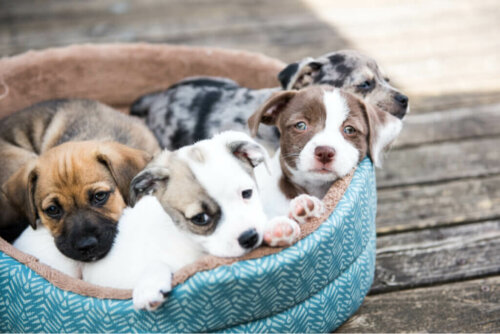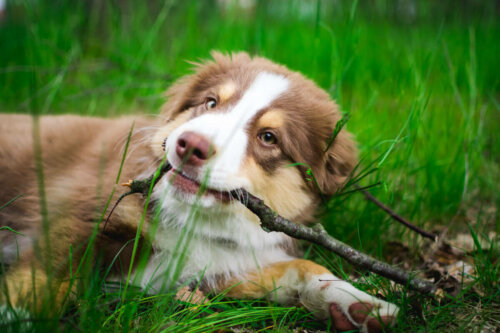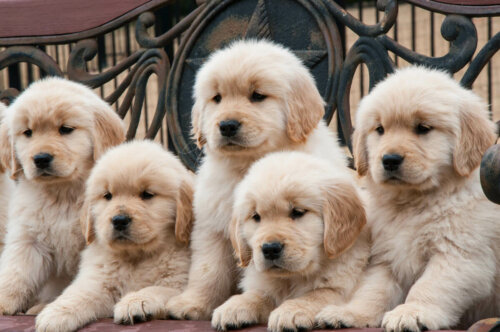Inbreeding Depression and How It Affects Dogs

Inbreeding depression is the term we use to define the lower reproductive rate in a population as a result of the pairing of closely-related dogs. This selection is common in purebred dogs.
Strong inbreeding reduces the litter size, a fact demonstrated in Golden Retrievers. Thus, a dog’s reproductive success is threatened by inbreeding, and knowledge of this phenomenon is necessary to improve breed preservation. To do so, breeders must ensure diversity in their lineages.
The importance of diversity within a breed
Inbreeding has many consequences in the lineage of an animal species; the prevalence of hereditary disorders, alterations in reproductive rate, morphological traits, and the permanence of rare diseases are some of them.
Since most purebred dogs descended from common ancestors, the expected degree of relatedness is already quite high. For this reason, genetic selection only exacerbates this situation which wouldn’t happen in nature.
Then, if you add the crosses between related individuals to obtain dogs with desired traits for sales i.e. a shorter muzzle, more wrinkles etc, you’ll see how selective breeding results in a fairly high inbreeding coefficient.
Other problems creep in when people select for traits in dogs.

Inbreeding depression – the closer two dogs are related, the fewer puppies they’ll have
The degree of relatedness influences the number of puppies a bitch gives birth to. The latest study by the Morris Animal Foundation found that a female Golden Retriever that’s 10 % more inbred than another will give birth to one less puppy per litter on average.
Selection in dog breeds
The selection of the various dog breeds has been on the basis of characteristics such as behavior, temperament, color, length and type of coat, size, and morphological traits. All to arrive at the canine varieties we know today.
This selection, with the exception of the work done to select working dogs or guide dogs, has been carried out by breeders all over the world. Breeders have done this without a defined selection organization or structure, but, rather, based on an individual’s information, according to the appearance and/or behavior of every dog.
As a general rule, the phenotypic value outweighs the genotype of that animal. However, the information provided by the parents – the genealogy or pedigree of the animal – can be an important factor when selecting individuals for crossbreeding. In many cases, taking this into account could prevent problems for future pet owners.
The new target in dog breeding
Due to the currently known number of diseases associated with breeds, organizations such as the Fédération Cynologique Internationale establish the following as the general objective of selective breeding:
“to obtain functionally healthy dogs, which can live a long and happy life, providing benefit and pleasure to the animal itself, the owner, and society”
As you can see, the selection of the species with the objective of utility or beauty has been put aside. Now the animals are sought in order to be suitable for human companionship. It’s necessary to increase their welfare and quality of life and reduce the occurrence of diseases associated with certain breeds.
Measures to decrease inbreeding depression
The goal of reducing inbreeding in dogs may seem quite difficult to achieve. However, experts have put together a series of recommendations in order to achieve it. Among them:
- Hiring independent consultants to advise on breeding in canine societies
- Conducting an evaluation of the standards of all dog breeds from the perspective of animal welfare and health
- Promoting the creation of a real register of epidemiological information
- Imposing restrictions against mating between close relatives, such as the number of unregistered offspring of a breeder
- Making an assessment of health status, which includes genetic merit and DNA testing for animals used as breeders
- Developing regulations for dog breeding practices
- Creating accreditation programs for breeders
- Promoting awareness programs for breeders and buyers
- Developing detailed breeding and breeding strategies for each variety

Inbreeding depression refers to a lower reproduction rate in dogs, but inbreeding has other serious consequences, such as the permanence of hereditary diseases over generations. This is why it’s important for breeders, researchers, and owners to reverse the current situation of some dog breeds.
All cited sources were thoroughly reviewed by our team to ensure their quality, reliability, currency, and validity. The bibliography of this article was considered reliable and of academic or scientific accuracy.
- Chu, E.T., Simpson, M.J., Diehl, K. et al. Inbreeding depression causes reduced fecundity in Golden Retrievers. Mamm Genome 30,166–172 (2019). https://doi.org/10.1007/s00335-019-09805-4
- Selección y cruzamiento en la mejora genética de las razas caninas. Cañón J, Cortés O. Laboratorio de Genética. Dpto. de Producción Animal. Facultad de Veterinaria, UCM.